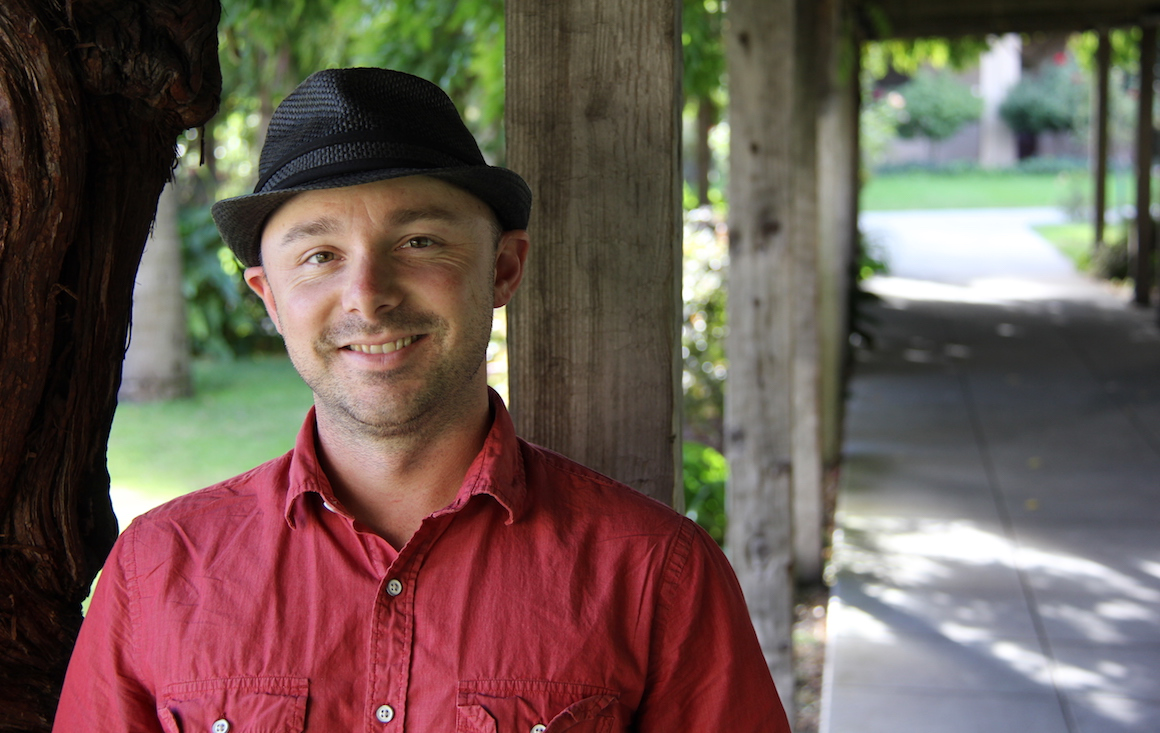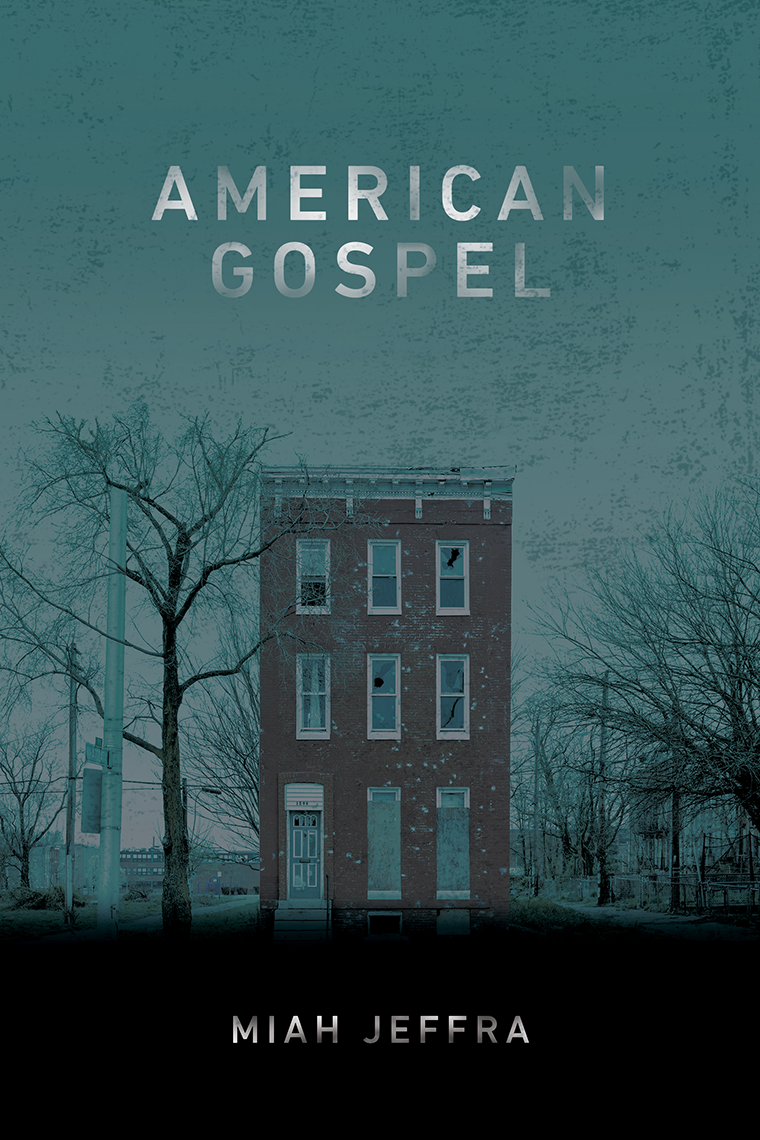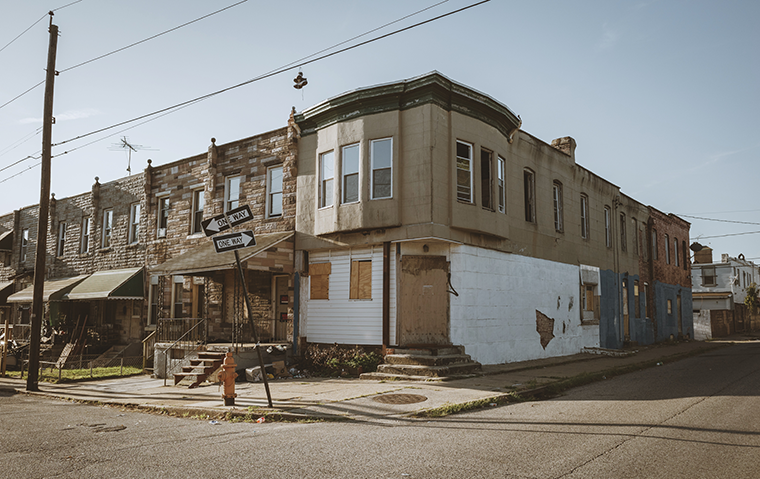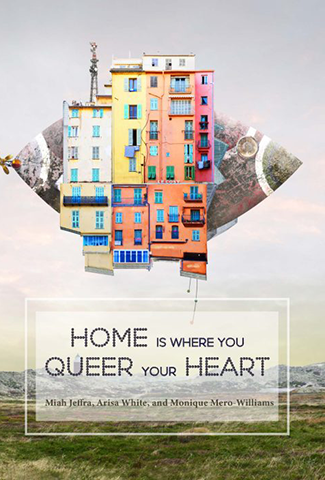Writing Toward Redemption

Baltimore, Maryland. Today, this port city off the Chesapeake Bay is home to a half-million citizens, and it boasts a rich history spanning hundreds, even thousands of years. However, for many, Baltimore exists in the public consciousness as a city on the brink, thanks to persistent headlines about crime, corruption, segregation, and poverty.
But even as lower-income neighborhoods are left behind to decay, in the last decade, real estate developers have flocked to this neglected city, promising to replace shuttered, sagging homes with shops, housing, and offices—likely to bring in millions of dollars of revenue and thousands of jobs—all while the people of these neighborhoods are quietly washed away by the rising tides.

Miah Jeffra, a lecturer in SCU’s English Department, hopes their latest novel American Gospel can better illustrate the complex effects of gentrification on this troubled city. In American Gospel Jeffra imagines a low-income Baltimore neighborhood targeted for redevelopment into a Baltimore-themed amusement park called “Crabtown.” In the midst of this impending gentrification, the novel follows three affected characters—Ruth Anne, a single mother on the run from an abusive ex-husband, her gay teenage son, Peter, and Brother Thomas, a priest-in-training at a local Catholic high school—as they navigate their future in this changing city.
Jeffra spoke with us about their novel’s compassionate approach to Baltimore’s story, the future of LGBTQ+ publishing, and the importance of literature in today’s world.
How did the idea for this novel start growing?
There are maybe two seeds. The first was the character of Ruth Anne who is definitely inspired by my mother. She was a single mother, and she got herself into a really precarious domestic situation with her second husband. So, Ruth Anne’s journey running from her estranged husband out of terror was the truest thing in the book, and it was my chance to write a redemption song for my mother. In many ways, that idea of redemption began to define the rest of the book.
The other seed was also connected to my upbringing since I grew up in low-income, urban-core Baltimore. Like most people, I wasn’t fully aware of my hometown and its systemic problems until I left. So, when I was doing my graduate studies in Los Angeles, I noticed how Los Angeles frequently erased its own history through urban renewal projects. It made me think about my hometown and what a lot of people call urban decay, or “blight.”
As readers, we get to inhabit each of your three main characters—including their unique problems and the ways their lives intersect with each other. How did you develop the role that Ruth Anne, Peter, and Brother Thomas would each play in the larger story?
At first, I saw them as connected: Thomas, a longtime local, would represent Baltimore’s history, Peter as its future, and Ruth Ann, running from violence, stuck in the present. Each of them is trying to redeem themselves in some way, and that’s the motivator for the changes they go through.
But with Thomas being the past, he felt like a loose thread. Out of the three characters, I didn’t really know how I wanted him to evolve by the end of the book. However, when I thought about how he was part of the Catholic Church, an institution that really obsesses about its history—sometimes, in lieu of the very people it’s serving—I realized that Thomas needed to become an activist in order to do the right thing. I was inspired to write his redemption as being his movement from inaction to action.

Homes in the Curtis Bay neighborhood in Baltimore. Photo by Baron Cole.
American Gospel is very character driven, and in many ways, the city of Baltimore becomes a character itself. Did you feel a sense of responsibility writing about this place?
When writers, or any kind of artist, create a representation of reality, you always want to create a portrait that is multi-dimensional—and that's super challenging.
Thinking about Baltimore, I didn’t want to only paint a bleak picture—I wanted to lend a lot of complexity to it. So, I tried focusing entirely on a smaller frame of reference that all of the characters dwell within.
The one departure from that in the book is in one of Thomas’ chapters, where he goes through the history of Baltimore, which I added to capture a little bit of the essence of Baltimore that’s outside of these moments of duress.
And hopefully, especially through Thomas’ character, I can show the beauty and interconnectedness of the city, its people, and its problems.
In a recent Rumpus interview, you said “not every queer story needs to be a coming out story.” Can you explain this idea and how you wanted Peter’s arc as a gay teenager to be different?
We have so many coming-of-age narratives, and they’re super important, right? They exist as these liminal rituals or signposts on the journey of being alive.
In this case of queer coming-of-age stories, most of the ones that actually get published are also the “coming out story,” which makes sense. Coming out stories are phenomenal, pivotal, and very interesting. We love them, and we can’t help but read them—even within the queer community, we share these stories a lot.
But a lot of the coming out stories that are published—or at least the ones that are legible to literary gatekeepers—have been about struggle and self-loathing. I feel like, since we are representing reality through these fictions, we also need to create alternative versions of the coming-of-age story for queer and trans people.
I really wanted Peter to not be concerned about his sexuality at all—he’s actually emboldened by it. Instead, his coming-of-age story was about where he fits in the grand scheme of things. His story was about challenging that traditional path of life—whether he should go to Columbia for college, how to be successful, struggling with his first love. Together, this coming-of-age arc takes on a different dimension and complicates that representation of reality that I feel queer and trans youth really need to see.
Speaking of Peter, his arc is driven by a desire to leave Baltimore for bigger cities like New York. By the end, he begins to see the possibility of a rich, authentic life as an out gay man in his hometown. Why was this important for you to explore?
Again, my goal was to create almost an antithetical coming-of-age story—in many coming-of-age stories, there are these themes of “following your dreams” and leaving the place you’re from. It’s something I did too. I left Baltimore because I didn’t feel like there was any opportunity for me because of the violence of my neighborhood, but now I can’t help but wonder what it would have been like if I stayed. What could I have provided that community? What does it mean to actually invest in a community?
So, it was like a little fantasy for me, but I also believe that if we keep telling the same narrative of flying the coop, it takes on this hegemonic positive value. I’m really interested in always pushing against what is a trending value so that it doesn’t get mistaken as truth.
There’s a debate in the literary world about whether LGBTQ+ stories should only be written by LGBTQ+ people. Some say it guarantees more authentic stories. Some say it puts a burden on LGBTQ+ writers. What are your thoughts on this?
I can intuit that someone who experiences life as a queer or trans person is going to bring that nuance around things like behavior and code-switching into their representations of it, right?
But with that being said, writers are in the business of creating worlds, and it would be criminal to just draw a line in the sand and say “If you are not this, you cannot represent it.” I think about what author Rebecca Makkai said when she wrote The Great Believers, which is about queer people, despite her not being queer herself. When she was asked about it, she essentially said “I don't need to apologize for writing across difference. I need to apologize if I get it wrong.”
Personally, if I’m writing a character that is beyond my own experience, as a rule, I tend not to try to process their experience of being that identity. They can meditate on other things, but for example, I would not write a Black character reflecting on their Blackness when there are so many Black writers who could write about that more successfully than me.

A recent Foglifter anthology co-edited by Miah Jeffra.
Why does meaningful representation matter when it comes to the publishing world?
The more exposure there is to something, the more it invites the ability to be complex and legible to others, right? That’s why I founded Foglifter—a nonprofit LGBTQ+ literary press—so it could be space in publishing that was dedicated to all the various complexities of the queer and trans experience, not just the ones that are clearly legible to a presumably straight audience. Even though the books and journals Foglifter publishes can be read by anyone, it was primarily designed by and for queer and trans readers.
Hopefully, through more and more of these kinds of complex experiences being published, more diverse depictions of queer and trans identity will become accessible to people that are outside of these communities. The goal is to expand the horizon of what constitutes “queer,” making it more difficult to marginalize.
So, there’s a lot of value in taking up space by and for people in places, institutions, and industries that are traditionally controlled by people who don't have the same interests, power, or privilege. That’s something I really resonate with.
What LGBTQ+ writers are you reading right now?
I read a lot of poetry, so that’s what immediately comes to mind. I’m reading Dior J. Stephens’ Cruel/Cruel from Nightboat Books—it’s amazing. Xan Phillips’ Hull—that’s so beautiful. Oh, and I recently read Arisa White’s Who’s Your Daddy? That was really terrific.
What’s it like balancing your writing career with your teaching career?
I have an equal love for teaching and writing. With teaching, I love the fact that I’m not buying or selling anything, and I’m able to engage and invoke the critical and creative. By teaching, I feel like I learn more myself.
I also love the mentorship involved in teaching, since writing can be really isolating. Through the community I have in teaching, I can share some of what I discover through my writing, while simultaneously having that meditative practice of processing what I see in the world—which is why I write.
Even though I don’t teach creative writing at Santa Clara, with the courses I do teach, I’m always making connections with ideas between what I write on the page and what I bring to the classroom, and then, what students bring to the classroom and what ends up on my page. The reciprocity is definitely there.
What lessons do you hope to give your students, and what have you been learning from them?
One of my goals right now is trying to break my students out of this idea that if they just follow the directions they will succeed. I feel like we somehow have raised a generation of students to check boxes, and I don’t think that’s how we develop problem solvers. We have to marry the critical and the creative, the reductive and the inductive. I want to inspire my students to cultivate a free-thinking and creative mind, no matter what their major is.
Meanwhile, I’m always thinking about the big picture, and they really teach me to refocus on what’s going on right now and observe it. I’ve really learned to be super present and patient as a teacher. I thank my students for that.
What advice do you have for young LGBTQ+ people who want to be writers?
First, I think it’s important to just dedicate yourself to writing in order to process your experiences, not writing in order to publish. If you write to publish, I think you’re short-changing the opportunity to be a vessel for the representation of reality. So many people get obsessed with the business of publishing, and I think that’s a trap.
Second, if you’re going to be a writer, it’s also really important to cultivate a sense of community and literary citizenship. Yes, writing is an isolating thing and you need time to dedicate to craft. But you also need to support other people that are trying to do the same thing. You never should think of them as being competition. I don’t think there is a place for competition in the arts—that’s also a trap. Especially as queer writers, we need to be there for one another, to buy each other’s books, to read with one another, to create opportunities for other queer writers.
What’s the value of literature for people who are not writers?
Wisdom.
Sadly, in our late-capitalist society, we think specialization and knowledge are what make us valuable. That’s bullsh*t, because information without wisdom goes nowhere.
Through literature, we have all this documentation of perspectives across time and space. If we amalgamate and engage with them, we might be able to cultivate our own sense of wisdom based on these perspectives. If we don’t engage in what people have communicated before, we make the same mistakes—so we absolutely, desperately need literature.
The SCU English Department is ranked #4 in the nation by the "25 Best Colleges for English Majors 2020" list compiled by gradreports.com.